Thành viên V&S Group
HỌC VIỆN GIAO DỊCH FOREX
Imagine this scenario. Price starts to rise. Keeps rising. Then it starts falling. And falling some more. And then it starts going back up.
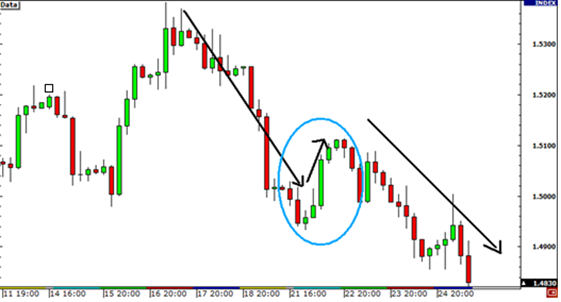
This is called the “Smooth Retracement!”
In the above example, the forex trader failed to recognize the difference between a retracement and a reversal.
Retracements are temporary price reversals that take place within a larger trend. The key here is that these price reversals are temporary and do not indicate a change in the larger trend.
Notice that, despite the retracements, the long-term trend shown in the chart below is still intact. The price of the stock is still going up. When the price moves up, it makes a new high, and when it drops, it begins to rally before reaching the previous low. This movement is one of the tenets of an uptrend, where there are higher highs and higher lows. While that is occurring, the trend is up. It is only once an uptrend makes a lower low and lower high that the trend is drawn into question and a reversal could be forming.
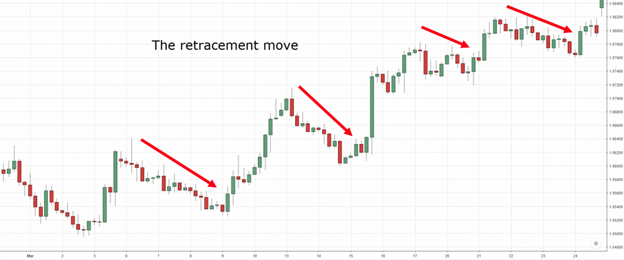
A reversal, on the other hand, is when the price trend of an asset changes direction. It means that the price is likely to continue in that reversal direction for an extended period. These directional changes can happen to the upside after a downward trend or the downside after an upward trend.
Most often the change is a large shift in price. However, there may be pullbacks where the price recovers the previous direction. It is impossible to tell immediately if a temporary price correction is a pullback or the continuation of the reversal. The change can be a sudden shift or can take days, weeks, or even years to materialize.
The moving average (MA) and trendlines help traders to identify reversals. Intraday reversals are important to day traders, but longer holding funds or investors may focus on changes over months or quarters. As shown on the image below, when the price drops under the MA or a drawn trendline, traders know to watch for a potential reversal.
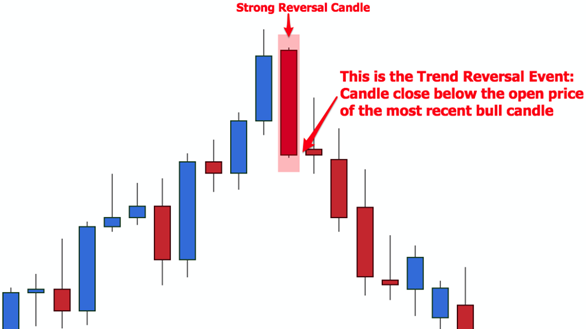
Properly distinguishing between retracements and reversals can reduce the number of losing trades. Classifying a price movement as a retracement or a reversal is very important.
There are several key differences in distinguishing a temporary price change retracement from a long-term trend reversal. Here they are:
|
|
|
|
|
|
|
|
|
|
A popular way to identify retracements is to use Fibonacci levels. For the most part, price retracements hang around the 38.2%, 50.0% and 61.8% Fibonacci retracement levels before continuing the overall trend. If price goes beyond these levels, it may signal that a reversal is happening. Notice how we didn’t say will.
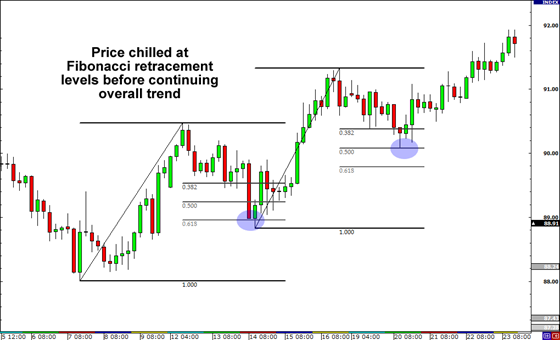
In this case, price took a breather and rested at the 61.8% Fibonacci retracement level before resuming the uptrend. After a while, it pulled back again and settled at the 50% retracement level before heading higher.
Another way to see if price is staging a reversal is to use pivot points. In an UPTREND, traders will look at the lower support points (S1, S2, S3) and wait for it to break. In a DOWNTREND, forex traders will look at the higher resistance points (R1, R2, R3) and wait for it to break.
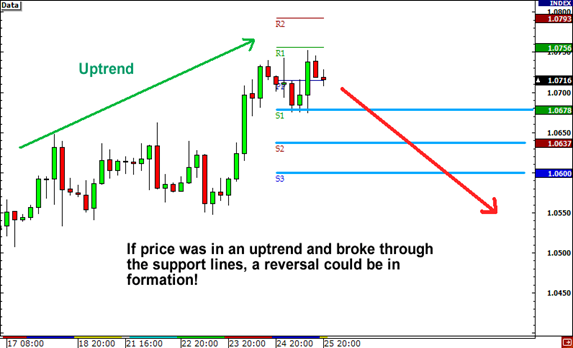
The last method is to use trend lines. When a major trend line is broken, a reversal may be in effect. By using this technical tool in conjunction with candlestick chart patterns discussed earlier, a forex trader may be able to get a high probability of a reversal.
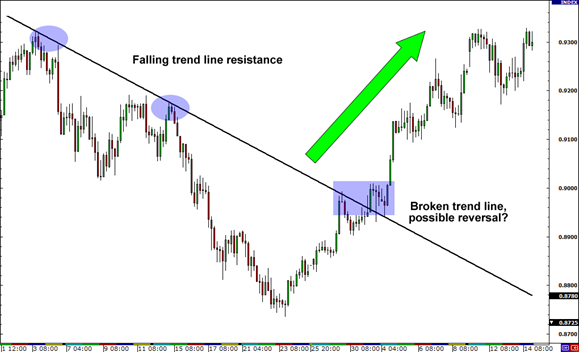
*The information presented above is intended for informative and educational purposes, should not be considered as investment advice, or an offer or solicitation for a transaction in any financial instrument and thus should not be treated as such. Past performance is not a reliable indicator of future results.

Hội chợ đầu tư Cairo 2021
Giải thưởng Siêu FinTech 2022
Fintech Châu Âu 2022
Giải thưởng Forex toàn cầu năm 2023
Hội chợ đầu tư Cairo 2021
Giải thưởng Siêu FinTech 2022
Fintech Châu Âu 2022
Giải thưởng Forex toàn cầu năm 2023
Bản quyền © 2024 - Đã đăng ký bản quyền.
Soho Markets LLC được thành lập tại St. Vincent & Grenadines với giấy phép số 1310 LLC 2021, cung cấp dịch vụ Giao dịch Toàn cầu.
Cảnh báo Rủi ro: CFD là công cụ giao dịch phức tạp và có nguy cơ mất tiền nhanh chóng do đòn bẩy. Bạn nên xem xét liệu bạn có hiểu cách thức hoạt động của thị trường CFD hay chưa và liệu bạn có khả năng chấp nhận rủi ro thua lỗ. Vui lòng đọc toàn bộ Cảnh báo Rủi ro.
Khu vực hạn chế: SOHO MARKETS GLOBAL LIMITED không cung cấp dịch vụ tại lãnh thổ trực thuộc Hoa Kỳ, Canada, Israel, Nhật, Triều Tiên, Bỉ và khu vực bị UN/EU trừng phạt.
Soho Markets Global Limited và Soho Markets LLC không cung cấp dịch vụ cho khách hàng khu vực Liên minh EU. Khách hàng tại khu vực EU sẽ chỉ có thể sử dụng dịch vụ của Vstar & Soho Markets Ltd.
THỎA THUẬN KHÁCH HÀNG (ĐIỀU KHOẢN VÀ ĐIỀU KIỆN) Chính sách Quyền riêng tư Cảnh báo rủi ro